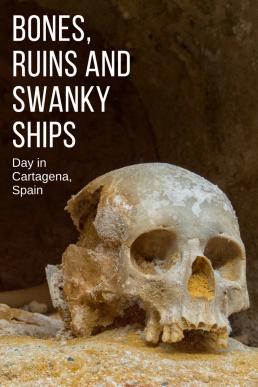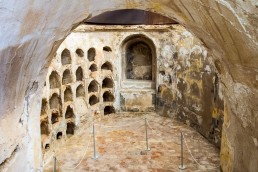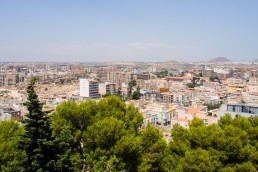Fill your day trip to Spanish Cartagena with exciting things to do and see: from quirky Roman ruins to shopping and pleasant walks under the ornamental balconies. Find the best views in Cartagena, explore the port area, and breath in the Spanish atmosphere over coffee or drinks.
Explore the History of Cartagena, Spain
Join me as strip the history of Spanish port town Cartagena on a short day trip. This multilayered city has seen Roman, Carthaginian, and Arabic rulers during the last 2200 years. In just one day you can dance with the dead in a medieval funeral crypt, feel the glory of the Roman Empire at several archeological sites, and crown the day with a sweeping view over the city from a colonial-era castle.
Cartagena’s vibrant past absorbs through your skin even on a short walk along the narrow streets. The old town of Cartagena is guarded by five hills just like in Rome. Ancient ruins are well presented in several intriguing museums, but glass-covered excavations dot the streetscape, too. It pays to look up constantly – I couldn’t stop photographing the plentiful ornamental balconies. Baroque, neo-classical and Art Nouveau architecture give Cartagena an extremely photogenic flair.
The old town is compact and easily navigated. The sights mentioned here are very close to each other. Walking is the most enjoyable way of experiencing the city, although bikes are also available.
Dance With the Dead in a Funeral Crypt
If you are on a daytrip in Cartagena and arrive with either train or bus, a museum called Centro de Interpretacion Muralla Punica makes the most logical first stop. Calle San Diego begins at the roundabout near the train and bus stations. Just follow it for a few hundred meters and you’ll see the museum on the right side. Downstairs you’ll find a chamber, which is believed to be the burial place of the Guild of St. Joseph. The crypt is well preserved and atmospheric, though small. “Dance with the dead” was the leading theme in murals, and the faded remains of skeletons still entertain scarce visitors. You will also be rewarded with some weary skulls and bones.
As an added bonus you can also visit the main sight here: the Muralla Punica ie. the Punic Wall. This Carthaginian wall was built in 227 BC with the foundation of the city, so it brings you to the very beginning of the storyline. The conserved stretch once marked the entrance of the city.
Most tourists seemed to visit only the wall, so be sure to make the detour to the crypt! Even after seeing the catacombs of Rome this funeral crypt felt a spectacular experience. Photographing is allowed and you are quite likely visiting the site alone, which are both rare treats in similar places in Rome.
Walk Around a Roman House, Casa de la Fortuna
Continue the same street, Calle San Diego, just a few hundred meters from the Punic Wall, until you reach Casa de la Fortuna – the House of Fortune. The adorable little museum is located inside a Roman House dating back to the 1st century BC.
This house, over 200 m2 wide, belonged originally to a wealthy merchant family. You can walk through the ruins of the house, seeing kitchen and dining room with an attached shop area, relatively small bedroom, and a vast atrium and representation rooms. At the rear end lays an entrance and a conservated stretch of the ancient road. Casa de la Fortuna is among the most enjoyable little museums I’ve visited. In a dimly lit, relatively tourist-free museum you can really imagine how the original Roman house around you has once looked.
To get to the next destination, the Roman Theatre, stroll through the old city and stop to have a refreshing café solo at San Francisco square. Then continue towards Plaza del Ayuntamiento through the main shopping street Calle Major.
Visit a Reconstructed Roman Theatre
Discovered in 1988 and rebuilt until 2003, the Roman Theatre is clearly the blockbuster sight of Cartagena. The site served as a theatre from 1st century BC to 3rd century AD until a market was constructed upon it in a very Roman way, using the old theatre as building material. In the 13th century the same grounds hosted a cathedral.
Entrance to the Museo del Teatro Romano is from the bustling Plaza del Ayuntamiento, just opposite the town hall. You have to walk through a multistoried museum to get into the theatre itself. A nice stroll among ancient statues, and through corridors and a crypt of the medieval cathedral transports you gently into the ancient times. It is allowed to climb the steps to the top of the cavea and you can test your acting skills at the stage as well.
Stroll Through the Port of Cartagena
Get some fresh air and wander towards the medieval castle along the seaside promenade, admiring swanky yachts and huge cruise ships. Throughout the history Cartagena has been one of the most important ports in the western Mediterranean. Phoenician traders docked here well before the city was founded by the Carthaginians in 227BC. During the Roman Empire this port town flourished under the name Carthago Nova. While Muslims expanded their kingdom to Spain in the 700s, once again Cartagena was in a major role due to its strategically located port.
Some of the boats are turned into restaurants and make a fun pitch stop. You can see the next destination, Castillo de la Conceptión, above the bay, watching over the city.
Take a Panoramic Lift to the Colonial Castle
Modern glass elevator lifts you 45 meters above the city, from where it’s a short hike to the colonial castle with 360-degree view over the city. The castle was built using the materials from the ancient amphitheater. At the time of my visit there were two small exhibitions, one about Leonardo da Vinci and another about the history of Cartagena. At the halfway the panoramic lift stops also at the Civil War Shelter Museum, which I didn’t have time to explore.
I don’t usually roam the museums during just short daytrips, but the museums of Cartagena were really fun to visit. Visiting all the four museums, walking through the port, and sipping one perfect café solo in the San Francisco square took really just 5 hours. Of course touring the city would be even more enjoyable, if you have more time to spare. I still plan to return some day just to linger over one or two nights. Cartagena really deserves an overnight visit, although you can pack much into a well-planned daytrip as well.
If you are visiting several museums in Cartagena, consider buying a “museum pass” consisting of four, five or six entrances (12/15/18 €). Passes are available at all sites. Just compare the prices before buying the pass, as the entrances to for example to Casa de la Fortuna and Muralla Punica/Funeral Crypt are really cheap (3,5/2,5 €).
Pin this story!

You May Also Like to Read:
Celebrating Feria de Sevillanas Carneval in Torrevieja
The vibrant mix of Andalucian horses, flamenco dresses, and Sevillan dance called "sevillanas" dominates the cityscape of Torrevieja for several days in May.
The Christmas Market of Tallinn’s Old Town
Feel the spirit of the Middle Ages at the Rathaus Square in Tallinn, filled with the tiny cottages selling everything from handicrafts to mulled wine.
Landing to San Juan de Nicaragua [Video]
Landing to the jungle airport of San Juan de Nicaragua with a 12 seat Cessna.
Valencia’s Old Town Merges Famous Sights With Street Art
Narrow alleys of El Carmen host a weird mix: subcultures and street art, orange gardens, old mansions, and the most iconic sights of the city.





















Did not know about this place, it looks so cool! Would love to travel there some day! Thank you for sharing!